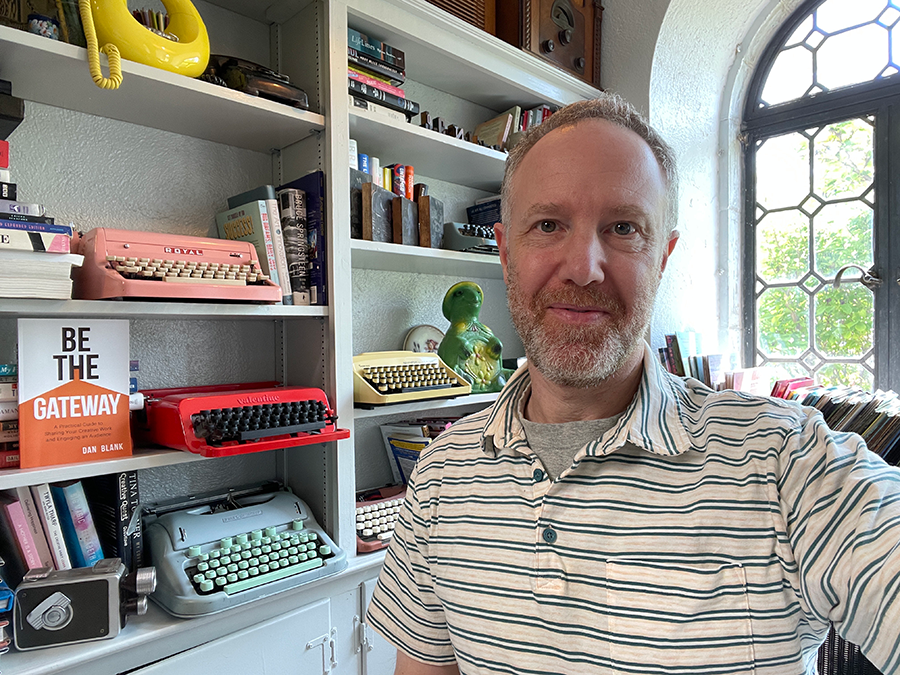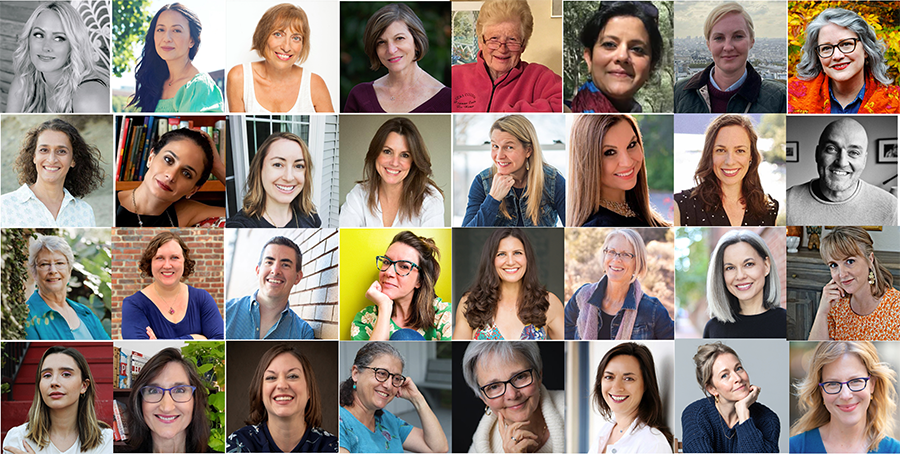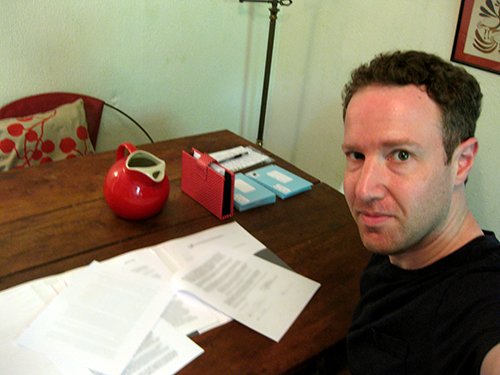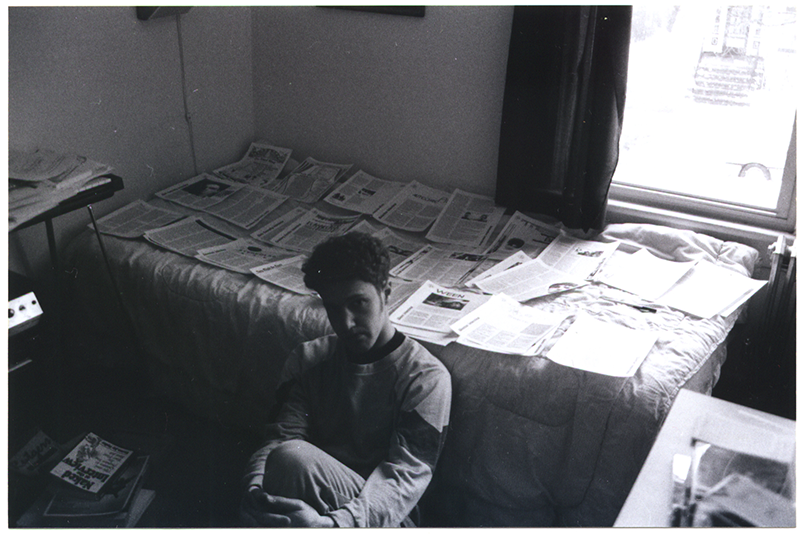I’ve sent out this newsletter every week for the past 18 years. Close to a year ago, I moved it over to Substack, and since then have seen it grown way faster than I expected. I’m reminded that each person who finds me comes in at a different time. So today, I want to reintroduce myself, talk about why I believe so passionately in helping writers share their work, and ask that you introduce yourself as well!
Okay, so let’s start with the basics: My name is Dan Blank and I live in New Jersey with my wife (who is an amazing artist, see her work here), and our two kids, who are 13 and 6.
Fourteen years ago I started my company, WeGrowMedia. That’s really just a fancy name for me working directly with writers and running workshops for writers. I work out of a private studio:

I spend my days helping writers:
- Develop and execute marketing plans for their books.
- Understand who their ideal readers are, where to find them, and how to engage them.
- Establish and grow their platforms, which may include developing their websites, social media, podcasts, newsletters, in-person events, and so much more.
- Find clarity in their work, knowing how to talk about their writing and managing it all with a sense of joy and meaning.
Over the years, I have worked with thousands of writers, including those who write memoir, nonfiction, fiction, children’s books, poetry, and seemingly every niche category. These writers have pursued all available publishing paths, including traditional, hybrid, and indie.
My days are spent in conversation with writers, which makes me the luckiest person in the world. Here are some of the lovely people I have had the pleasure of working with:

I do this work because I believe:
- Everyone can be creative, and that your unique creative voice should be heard.
- When we share what we create, the world becomes a better place.
- How we share is a craft, one that can be filled with joy and deep purpose.
That is what I try to share here in The Creative Shift every week. You may notice that I often share examples from a wide range of creative fields, including film, music, illustration, and performing arts. I believe there is so much to learn from other creators about the opportunities and challenges of what it means to share your voice and connect with your ideal audience.
Along the way, I have authored a book — Be the Gateway: A Practical Guide to Sharing Your Creative Work and Engaging an Audience — as well as shared 1,000+ essays, run hundreds of workshops and courses, been a part of many podcasts, and shared 35,000+ social media posts.
Every writer has their own journey and creative vision. It is truly an honor to be the tiniest part of helping to share what they create.
Before this, I worked for a decade at a large publisher of trade magazines. There, too, my days were spent with writers, including journalists, reporters, editors, and the many other roles in magazines such as Publishers Weekly, Library Journal, School Library Journal, Variety, Interior Design, and dozens of others.
I worked here during the huge transition that publishers were making from print to digital. I ended up helping to launch the company’s blog initiative, training 300 bloggers, as well as helping to establish the social media strategies for dozens of brands. Of course, I assisted in newsletter strategies too.
This is where my own newsletter began. It started with me needing to ask permission. I told my boss I wanted to share a small weekly newsletter that helped the writers and business leaders in our company embrace how to connect with readers online. Thankfully, she gave me permission. Communications in the company were tightly controlled, and she was in charge of the formal company newsletter. It felt like a big step that she would approve a (dramatically) smaller one, run entirely by me.
I walked around to the desks of 9 people I knew and asked if I could send them the first issue.
What happened next was unexpected, and a little harrowing. This is the moment that everything changed for me, when it became possible for me to work full-time on my own, spending my days doing creative work that I love. (Though that wouldn’t happen until years later.)
One of the 9 people I emailed was a lawyer for our company. He replied back that he thought I should send it to our CEO, and that he would appreciate it. I resisted. Emailing the CEO seemed like the type of thing that a guy sitting in a gray cubical didn’t do. Too often, in corporate culture, you don’t raise your hand in order to stand out. You simply try to fit in.
My colleague gave me an ultimatum: if I didn’t email it to the CEO, he would. My cube was near all of the executive offices, and this was the chain of events:
- I asked my boss permission to forward the newsletter to the CEO. She approved.
- I forwarded the first newsletter to the CEO saying that it was suggested I forward it to him, and that he may appreciate it.
- A few minutes later, I saw the CEO walk out of his office, past my cube, and into my boss’s office. He shut the door. Welcome to the longest 5 minutes of my life.
- Five minutes later he went back to his office.
- Thirty seconds later, my phone rang and my boss called me into her office.
- When I arrived, she asked me to close the door and sit down.
At this point, I was 100% convinced that I was about to be fired. Why? Not only because I had spoken up within a corporation, but because the topic I was writing about (how digital media will affect writers, readers, and impact our revenue with print media) represented a huge threat to the company’s core business model, and to many of its employees.
Then she said something unexpected: “The CEO would like to forward your email to the entire company, suggesting that everyone subscribe.”
That instantly boosted my subscriber base to well more than 9 people. Within the company, I became well-known. I had advocates, but I’m also well aware that I had detractors — those who did not like what I had to say, and were not supportive of my ability to share so easily within the company.
This experience taught me so much about the power of sharing your voice, but also about the importance of advocating for others. When my colleague gave me the ultimatum, “I think you should share this with the CEO. If you don’t, I will,” he became a staunch advocate for me and what I believed in. His involvement was not passive — a simple “like” on a social media post. He focused on amplifying my voice.
Through what he did, what my boss allowed, and what the CEO insisted on, a chain of events happened that has lead me to where I am today. In many ways, I got lucky. In other ways, what I did with that luck shaped what was to come next. If I had just sent 10 newsletters and then stopped, nothing would have changed. But I kept going, sending newsletters week after week, and in the process I learned more about who I was and who my readers were. This journey continues today with this very newsletter, and you reading these words. (Thank you!!!)
In 2010, that company was eventually sold and split up. I stayed until the very end. I never looked for another job, and instead started WeGrowMedia. Below is a photo of me signing my severance agreement. To the right is the stack of invitations for the baby shower for our first child. It was a huge risk for me to try to earn a living on my own while we are just starting a family. But I knew then that if I didn’t do it in that moment, I never would:

Before all of this, in the late 1990s I worked at a series of startups in New York City during what was known as the Dot Com 1.0 Bubble. I did writing, design, and marketing. These were the first online companies who were riding the wave of internet success.
The startups I worked for didn’t make it. At one company, I remember the eerie feeling of walking into work one day and everyone whispering that the Chief Financial Officer just quit because there was no more money, signaling dire straights for the rest of us. Soon after, in a moment of company desperation, we were all asked to literally walk out into the streets and go to Washington Square Park to stop anyone we could and tell them about our company. Our product hadn’t yet shipped. It was a very odd feeling.
So often I write about connecting with your audience early in your process of sharing what you create. This story is why. I think back to that moment as the experience we all want to avoid: vying for any attention when it is already too late.
In college I studied communications — everything from the media and mass communication to interpersonal and nonverbal communication. My professors had us run experiments to observe human behavior. One day, we were asked to go to a random building on campus, get on a crowded elevator and simply face the opposite way as everyone else to see how others reacted.
Another assignment was to go to the student center and observe the patterns and exchanges between students — from friends to strangers. All of this study certainly shaped my own process of research and observation that I share in case studies on how writers can best connect with readers.
I had another focus in college, which is publishing my own music zine with a friend. I loved Britpop and what was called “alternative music” back then. So I began cold calling record companies, and eventually developed contacts at all of the major labels. The result was hundreds advance copies of new albums, free access to concerts, and interviews with some of my favorite bands at the time, including: Oasis, They Might Be Giants, Blur, and Weezer. This is me laying out an issue in the early 1990s:

The cost of printing these issues all went on my credit card, and it took me years of working minimum wage jobs to pay off that debt. But, it was worth it.
Growing up, I was the art kid. At age 5, my mom enrolled me in art classes in Mrs. Flannigan’s basement. Her walls featured these huge 20-foot-long murals, with art supplies spilling over on the shelves. It was magical.
In the years that followed, I explored illustration, painting, sculpture, photography, paper engineering, and so much else. Then, of course, came the writing. At first this was in service of the visual stories I was telling. But soon my life as a teenager was filled with writing poetry and prose.
It’s weird to write all this out. Living it, every milestone and era felt kind of random. But looking back, I see such a clear thread between the different phases of my life, and the work I do with writers now.
Now it is your turn! Let me know in the comments, what do you create, why does it matter to you, and what was the journey that lead you here?
Thank you for being here with me.
-Dan
